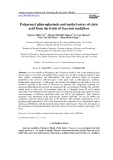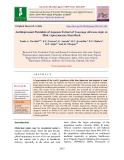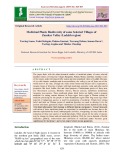
Ethno medicinal plants
-
Garcinia multiflora belonging to the Clusiaceae family is one of the medicinal plant species native to Viet Nam and southern China and its use is an ethno-medicinal remedy to treat acne, scabies, constipation, and inflammation. In this paper, the chemical investigation on the fruits of Garcinia multiflora growing in the north of Vietnam was reported.
 9p
9p  viamancio
viamancio
 04-06-2024
04-06-2024
 1
1
 0
0
 Download
Download
-
The present study was to document ethno medicinal plants used against health disorders and diseases in Marwar region of Rajasthan, India and to select potential medicinal plants for further in vitro and in vivo investigation. An ethno medicinal plant exploration was carried out in Marwar region of Rajasthan in the year 2017-18. Data on ethno medicinal plants ethnographic profile of the respondents was documented using semi structured questionnaires.
 17p
17p  chauchaungayxua10
chauchaungayxua10
 18-03-2021
18-03-2021
 7
7
 2
2
 Download
Download
-
Calotropis a medicinal plant of family Asclepiadaceae has been utilized in Ayurveda, Unani, Siddha and many other traditional systems to cure diseases. There are two common species of Calotropis viz. Calotropis gigantean (Linn.) R.Br. and Calotropis procera (Ait.) R.Br. Calotropis gigantea called Swetarka and Calotropis procera called Raktarka. Secondary metabolites of Calotropis have well known pharmaceutical and therapeutic applications. Chemical constituents of plants such as alkoloids, steroid, terpenoids, resin, glycosides, carbohydrates, etc are reported in Ayurvedic literature.
 9p
9p  angicungduoc6
angicungduoc6
 20-07-2020
20-07-2020
 7
7
 1
1
 Download
Download
-
India is home to a great variety of ethno-medicinally important plant species and is ranked sixth among 12 mega-diversity countries of the world (Joshi et al., 2001). Medicinal plants as a group comprises approximately 8000 species and account for around 80% of all higher flowering plant species of India (Samant et al., 2002). The Indian Himalayan Region (IHR) comprises of five biogeographic provinces i.e. Trans, North West, West, Central and East Himalaya and covers approximately an area of 591 thousand km2 (Rodgers and Panwar, 1998).
 19p
19p  quenchua6
quenchua6
 15-06-2020
15-06-2020
 10
10
 1
1
 Download
Download
-
The Acanthaceae family is an important source of therapeutic drugs and ethno medicines. There are many famous medicinal plants from this family, such as Andrographis paniculata, Baphicacanthus cusia, and Dicliptera chinensis. Justicia procumbens (J. procumbens) is widely distributed in tropical and sub-tropical of the world.
 15p
15p  vijiraiya2711
vijiraiya2711
 27-05-2020
27-05-2020
 14
14
 1
1
 Download
Download
-
A large number of the world’s population suffer from depression and anxieties at some points in their life time, the sufferers are however sceptical about the available orthodox drugs largely because of side effects, cost and availability. This present study was aimed at evaluating the antidepressant potentials of Voacanga africana to query its ethno medicinal claim. The extract of the stem-bark of the plant was screened for its phytochemical composition, and antidepressant potentials assessed using forced swimming test (FST) and tail suspension test (TST).
 7p
7p  nguaconbaynhay4
nguaconbaynhay4
 22-03-2020
22-03-2020
 10
10
 3
3
 Download
Download
-
Medicinal plants are an important source for the research of active molecules against diseases. The plants used in this setting are rich in therapeutic substances. This study aimed to collect the ethno-medical use of Acanthospermum hispidum in the Central West region from resource persons and to determine these pharmacognosic characteristics. A survey collected information on Acanthospermum hispidum using a sheet. The whole plant has been used for pharmacognosic characterization through histochemistry and biological activities. There was strong use of the plant in the Central West region.
 12p
12p  caygaocaolon3
caygaocaolon3
 27-02-2020
27-02-2020
 17
17
 1
1
 Download
Download
-
The paper deals with the ethno-botanical studies of medicinal plants of some selected Zanskar valleys covering four villages Rangdum, Padum, Muney and Raru. Zanskar is one of the remote, under developed, hilly region and least populated valley of Ladakh. Because of its cold climatic condition and in accessibilities, the valley is cut off from rest of the world most of the time. Though the valley looks barren and lifeless still it represents a treasure house of diversity of plants with high medicinal, aromatic value and other useful properties like food, fodder, fuel and ritual purposes.
 9p
9p  chauchaungayxua1
chauchaungayxua1
 04-12-2019
04-12-2019
 12
12
 0
0
 Download
Download
CHỦ ĐỀ BẠN MUỐN TÌM





















